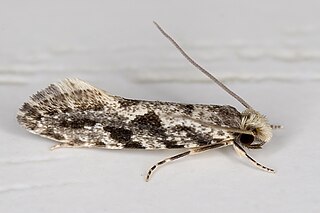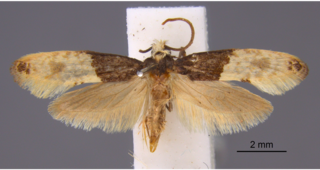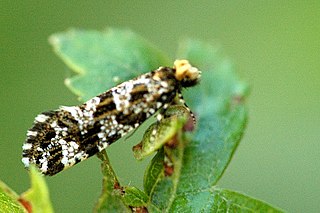
Dyseriocrania subpurpurella is a diurnal moth from the family Eriocraniidae, found in most of Europe. The moth was first named by the English entomologist, Adrian Hardy Haworth in 1828.

Monopis obviella is a species of tineoid moth. It belongs to the fungus moth family (Tineidae), and therein to the nominate subfamily Tineinae. It is the type species of Blabophanes, today treated as a junior synonym of the genus Monopis. M. crocicapitella was only separated from the present species in 1859, and is still frequently confused with it even by rather recent sources.

Morophaga choragella is a moth of the family Tineidae. It is found in Europe.

Nemapogon granella is a species of tineoid moth. It belongs to the fungus moth family (Tineidae), and therein to the subfamily Nemapogoninae. It is the type species of its genus Nemapogon, and via that also of the subfamily Nemapogoninae. It is also the type species of the proposed genera Brosis and Diaphthirusa, which are consequently junior objective synonyms of Nemapogon.

Trichophaga tapetzella, the tapestry moth or carpet moth, is a moth of the family Tineidae. It is found worldwide.

Triaxomera parasitella is a species of tineoid moth. It belongs to the fungus moth family (Tineidae), and therein to the subfamily Nemapogoninae. It is widespread and common in much of western Eurasia, but seems to be absent from some more outlying regions, such as Portugal and the eastern Baltic, Ireland and Iceland. It has also not been recorded from Slovenia but given that it is found in neighboring countries, it may well occur there unnoticed. Recently, the species was recorded from British Columbia. Generally, it is a moth of warm temperate regions, e.g. in Great Britain it is only a rare and scarce species from the English Midlands northwards.

Tinea semifulvella is a species of tineoid moth. It belongs to the fungus moth family (Tineidae), and therein to the nominate subfamily Tineinae. It is widespread and common in much of the western Palearctic, but seems to be absent from Portugal and the Balkans as well as the outlying islands. The nocturnal adults are on the wing around May to September, depending on the location, and are easily attracted to light sources.

Tinea pellionella, the case-bearing clothes moth, is a species of tineoid moth in the family Tineidae, the fungus moths. This species has a cosmopolitan distribution, occurring nearly worldwide.

The brown-dotted clothes moth is a species of tineoid moth. It belongs to the fungus moth family (Tineidae), and therein to the nominate subfamily Tineinae. It is the type species of its genus Niditinea.

Monopis laevigella, the skin moth, is a species of tineoid moth. It belongs to the fungus moth family (Tineidae), and therein to the nominate subfamily Tineinae. It is the type species of the genus Monopis and its junior objective synonym Hyalospila. As with the common clothes moth, earlier authors frequently misapplied the name Tinea vestianella to the present species.

Tinea trinotella is a species of tineoid moth. It belongs to the fungus moth family (Tineidae), and therein to the nominate subfamily Tineinae. It was once used as type species of a distinct genus Acedes, but this is synonymized today with Tinea, the type genus of Tineinae, Tineidae and the superfamily Tineoidea.

Tinea is a genus of the fungus moth family, Tineidae. Therein, it belongs to the subfamily Tineinae. As evident by its name, it is the type genus of its subfamily and family. Established as one of the first subgroups of "Phalaena", it used to contain many species of Tineidae that are nowadays placed in other genera, as well as a few moths nowadays placed elsewhere.
Coleophora salicorniae is a moth of the family Coleophoridae. It is found in most of Europe, including the Mediterranean islands and Cyprus. It is also known from central Asia, Iran and the Canary Islands. It occurs in desert biotopes and salt-marshes.

Infurcitinea argentimaculella, the silver-barred clothes moth, is a moth of the family Tineidae. It was described by Stainton in 1849. It is found in most of Europe, except Ireland, Portugal, Latvia, Lithuania and the Balkan Peninsula.

Tinea pallescentella, the large pale clothes moth, is a moth of the family Tineidae. It is found in most of Europe. It is also present in western North America, where it has been recorded from California. There are also records from South America and Australia.

Tinea svenssoni is a moth of the family Tineidae. It is found in northern Europe, Russia, as well as North America where has been recorded from Québec.
Tinea porphyropa is a cave-dwelling moth of the family Tineidae. It is known from Sumatra, Indonesia and Malaysia.
Tinea antricola is a cave-dwelling moth of the family Tineidae. It is known from India, Sumatra, Indonesia and Malaysia.
Tinea flavescentella is a species of moth belonging to the family Tineidae. It is native to Western Europe. The wingspan is 8-17 mm. Head with pale yellow hair tuts. Antennae just over half the front wing length. The forewings are greyish yellow with two or three grey-brown spots and a faint hyaline spot at the base. Hindwings grey. Certain identification requires examination of the genitalia.Flies at night in August. It is found indoors where fur and wool goods are kept.
Tinea dubiella is a species of moth belonging to the family Tineidae.















